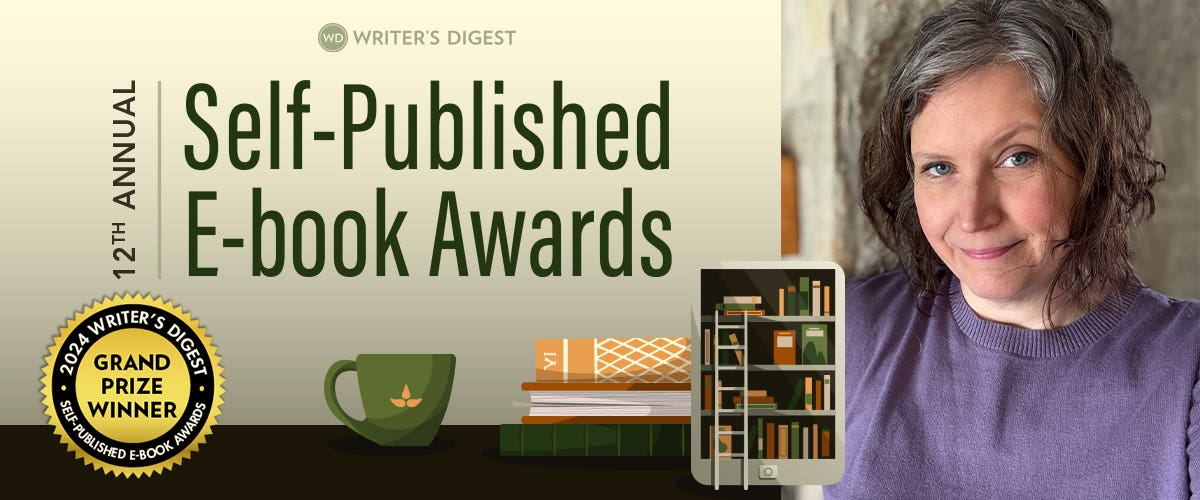7th Annual Pop Fiction Writing Competition Winner: Science Fiction
Here’s the winning entry for the Science Fiction category for the 7th Annual Writer’s Digest Popular Fiction Writing competition by marketing specialist Maggie Bresonis.
Here's the winning entry for the Science Fiction category for the 7th Annual Writer's Digest Popular Fiction Writing competition by marketing specialist Maggie Bresonis.
Counterparts
I was slouched in the London waiting room of the Institute of Counterpart Research when the news broke that Flora McAvery was dead.
Up until that point, I had spent the better part of thirty minutes sitting in a whitewash of boredom, absently reviewing the case file of the anonymous client I had been called in to see on behalf of a vacationing colleague. Mildly put out at having to drive in from our Chelmsford office to deal with a client that wasn’t my own, I’d spent no more than a few minutes evaluating the case file in my lap.
It was textbook, of course; they always were. A forty-something female, wishing to remain unidentified, had visited the ICR roughly three months ago in an attempt to match to a Counterpart. According to my colleague’s notes, the DNA match had been a success—her Counterpart identified as one Gabriel Sullivan, deceased. She did not take the news well. Subsequent efforts at therapy, both psychological and medicinal, had come up short. My colleague had done his best to help counsel her through the grief during her regular monthly sessions, but the woman had become prone to requesting emergency appointments when the bouts of depression became too much to endure.
I sighed. It was a common story among the Unpaired and one that certainly came with a justified burden of grief. But, that burden, which had at one time been quite bearable, had evolved over the past decade into something oppressive and absolute. No longer did one mourn the loss of their unknown mate and move on. No, being Unpaired nowadays had somehow become tantamount to a life sentence. There were no words of comfort; no silver linings to be had; no other fish in the sea—only the most absolute belief that there was nothing left but a lesser life to live.
It was an absurd conviction, and one that my wife, Kathryn, lobbied hard to upturn. She’d made a career out of publicly questioning the social ramifications of Counterpart Technology and was considered a top name in her field. Still, things being what they were, her livelihood was beginning to show the unmistakable signs of decay. After all, what good is a voice of reason if people no longer care to listen? The effects of futility were evident on her face when she returned from the office each day, and again in the morning when she kissed me goodbye. Of course, it hadn’t always been this way.
In its earlier days, Counterpart Technology was considered questionable at best. It had begun on shaky legs, the experimental brainchild of Alan Flemming and Lars Ahlstad—two geneticists that had spent their formative doctoral years studying the monogamous nature of prairie voles. I don’t pretend, nor do I really care, to understand the biological particulars at the root of vole monogamy. Nevertheless, I’d gathered enough information to know that it had something to do with a reciprocal chemical reaction known to produce feelings of mutual euphoria. When it was publicly theorized by these men that similar genetic triggers could be activated in humans, they were all but laughed out of the scientific community.
Since their study required a vast pool of unique DNA samples with which to work, it was imperative that they have enough money to attract willing blood donors. But without a major institution to back them, the research was dead on arrival and that’s where the story should have ended. It wasn’t until March of that year that they received an unexpected and rather generous grant, bestowed by an anonymous patron, which allowed them to keep the research in motion. With the grant in place, the payout to a single donor was both absurd and unprecedented.
Consequently, it didn’t take long for the research to gain momentum. It was easy money for anyone who wanted it, and a no-brainer to those desperate to pay off their debts. Having rather significant student loans at the time, I can confess that I, too, was a beneficiary of those initial donations. Lord knows, if Kathryn ever became aware of this fact, she’d have my head for it. In any case, the compensatory system was a win-win and it took just six short years for Flemming and Ahlstad to produce their first Counterpart pairing.
Initially, the media treated the entire event as a hoax; but the attention given to the situation, regardless of its context, drove a flood of new donations and it wasn’t long before more Paired couples began to surface. As both negative and positive publicity grew, so did the interest from the greater scientific community. Outside studies were launched to validate the research and the scientists that had once been spurned were ultimately vindicated. When the media finally performed their about-face, the discovery was tragically dubbed “the soulmate code” – an eye-rolling moniker that seemed asinine to most but still managed to nurture the imaginations of many.
In spite of this, most people remained skeptical and those that were already in happy relationships saw no reason to pull up stakes. Those attempting to match to a Counterpart were typically young singles or divorcees and even they still regarded the system with a healthy suspension of disbelief. Some would pair, some wouldn’t; but, regardless of the results, life went on. My Kathryn and I, happily Unpaired and married for 11 years, could attest to that.
It wasn’t until the Paired became more commonplace that the problems began to surface. As their numbers grew, it became increasingly apparent that there was something elevated about their existence. When compared to even the happiest of couples, it was obvious that the Paired were on a noticeably different plane. Theirs was an idealized, storybook love- characterized by mutual devotion and eerily devoid of anger and conflict.
What’s more, these feelings didn’t seem to deteriorate with time. Nor did they seem pervious to outside influence. Rather, the unique biological footprint that called one half to the other seemed to operate completely independent of circumstance and environment. Career troubles, emotional stress, and financial struggles still existed for them, as they did for any other, but never in such a way that it would begin to chip away at the hallowed nature of their relationship.
Perhaps most astonishing was the total indifference of the Paired toward personal preference. The distinctive factors that once comprised a person’s type—looks, education level, wealth, race, creed, politics, criminal record—had become completely arbitrary. The chemical reaction induced by that first meeting between Counterparts simply trumped what the brain would have once identified as an insurmountable difference. Admittedly, the entire thing was extraordinary.
So, you can see where perceptions might begin to change, and change they did. Divorce and annulment rates hit all-time highs as the Institute of Counterpart Research became overwhelmed by consumer demand. In response, localized satellite facilities were built across the globe and the ICR began charging for the very services for which they once provided compensation. They could name their price—and did—and banks responded almost immediately with the establishment of Counterpart loans. Parents began submitting their children’s DNA early in order to benefit from reduced pricing, and it soon became commonplace for hospitals to offer DNA extraction post-delivery.
The youngest generations, of course, were the worst affected by the counterpart fixation, being largely ignorant to a time without it. Nowadays, most of them grew up the children of Paired parents and those that didn’t were groomed by society to anticipate a Paired lifestyle. The tendency of Paired couples to gravitate toward each other led to a boom in segregated living communities – which only served to further limit their daily exposure to the Unpaired. No one needed to explain why these communities had become so popular; it was obvious that they simply felt more comfortable among their own.
I’d never admit this to Kathryn, but I’m not as opposed to the voluntary move toward segregation as she is. There is nothing more irritating to me than the abject pity that emanates from a Paired person at the moment they discover that you aren’t. The way they falter in their train of thought, as if they’ve just made a horrifying faux pas. The surreptitious glance toward the wedding band on my finger as they pigeonhole me into the substandard relationship they reason I must have. I’d long ago learned to tiptoe around conversations that had the potential to give away my status, careful to keep my interactions to those who already knew, and had long ago accepted it.
Still, there were always exceptions to the rule and, a year ago, that exception came in the form of Flora and Addison McAvery. The McAvery twins became a worldwide sensation when they famously matched to the same Counterpart, Johan Petro, during their interim year. Though likely not the first identical siblings to match to a single Counterpart, they were the first to go public with their story. Many theorized that other multiples had been paid to keep their shared results quiet but, in the months following the McAverys’ debut, investigations into ICR records showed that not a single pairing had ever occurred among people with identical siblings. It didn’t seem possible. Rumblings of bribery quickly turned into cover-up conspiracy theories—particularly so when it came to light that the Counterpart Specialist assigned to the McAverys’ case had been terminated under suspicious circumstances.
Conspiracy theories, though, weren’t the only thing keeping the public glued to Flora and Addison’s story. Rather, the reason for their celebrity was rooted in their stunning mutual decision to choose each another over their shared Counterpart. It was a choice overflowing with controversy and one that put the rejected Johan Petro in the middle of a media maelstrom. Still, the twins held their ground, speaking candidly about their situation. Polygamy, it seemed, wasn’t an option. The imbalance of the two to one union would, chemically speaking, dilute the effects—thereby making it impossible to form the pair-bond. They couldn’t both have him, so it was mutually decided between the sisters that neither of them would.
Kathryn, of course, was invigorated by the publicity. She’d spent the last 10 months travelling back and forth to Glasgow on behalf of her firm, integrating the McAvery girls into her latest crusade efforts. The schedule was taxing and she was often exhausted but, to her, it was very much worth the effort. Flora and Addison McAvery represented everything she’d been working to achieve over the last decade, giftwrapped and hand delivered in a publicity-friendly package. The sisters were poised to become the voices of a social revolution and Kathryn was convinced that their influence would be corrosive to the segregation and prejudice that had come to define the last decade.
It was with those thoughts in mind that I now sat slack-jawed and rigid, the case file in my lap forgotten as I openly gaped at the story unfolding disjointedly across the screen. Details were scarce, but the facts were clear: Flora McAvery was dead, smothered in her sleep, her sister in custody and awaiting arraignment. For ten minutes, the screen flashed a continual loop of amateur footage depicting Addison being steered away from her house in handcuffs. She looked ragged and ghostly—a shell of the girl the world had come to know over the past year.
The information was slow to trickle in but, when it did, reporters made sure to acknowledge that it was largely unverified. Sources close to the matter were claiming that both Addison and Flora had been separately intercepted by Johan Petro approximately six months ago. To be honest, that’s all they really needed to say; the implication was clear enough. There was no known way to prevent the chemical response initiated between a matched pair and the subsequent bonding was inevitable. Addison and Flora’s desire to put their sisterhood first would have been shattered in the very moment they each made contact with Johan. It was only a matter of time before the entire situation came to a head and, in this case, it was Flora who paid the price. I felt sick—sick for Flora, sick for humanity, but, most of all, sick for what this would mean for Kathryn.
“Dr. Perry?”
“Hmm?” I looked up sharply, startled by the interruption from the petite woman at the front desk.
“Dr. Perry, the client is ready for you in Exam 3.”
“Oh, yes. Right. Of course. Thank you.”
I took a moment to compose myself and quickly gathered the papers that had fluttered to the floor while I’d sat preoccupied by the day’s turn of events. Giving a quick nod in the direction of the petite woman, I pushed through the entrance to the examination bay and paused before the white door displaying the number three. I took a few deep breaths to shake off the tension I’d been feeling for the past quarter hour and gave a quick courtesy knock before turning the handle to let myself in.
When our eyes met from across the small room, I was momentarily taken aback. Kathryn. How did she know where to find me? Did she hear about Flora and phone the office? Did they tell her I was here? But something about the horrified look on her face was off and it hit me then that it was my presence, not Flora’s death, that was the source of her reaction.
I felt the shock slam into me as I registered the guilt on her face, the force of it causing me to stumble backward into the doorframe.
Her name was a whisper on my breath and the only word I was able to get out before my stomach lurched violently. I found myself struggling to inhale, the simple act of breathing suddenly and monumentally more difficult. I stared at her stupidly, willing her to just disappear. This wasn’t happening. This wasn’t her. She’s not supposed to be here.
She started sobbing, nearly hyperventilating, and I realized after a few moments that she was struggling to say something through her frenzied gasps. It took me a minute to make out the words and, when I did, I was surprised to feel nothing.
I’m sorry. Over and over again, I’m sorry—the words strung together like a chant.
I’msorryI’msorryI’msorryI’msorry.
But she wasn’t sorry. She was here. Here because he wasn’t; here because she couldn’t find a way to deal with that; here because I wasn’t enough. For a moment I let myself wonder what would have happened to us had her Counterpart still been alive when she’d matched three months ago. Would she have left me then? I felt a momentary swell of rage push through the sorrow when I thought about the depth of her hypocrisy, but I was too weak to sustain it. The guilt radiated off of her and I swear I could feel it scraping across my skin like sandpaper. It was easier to be numb.
I watched her rock herself back and forth, knees drawn up to her chest. I watched her sob and chant her apologies. I watched because I couldn’t will myself do anything else, least of all leave. I don’t know how long we stayed there like that—silent, mutually devastated and irreparably broken.
When her sobs had given way to a quiet weeping, I stood from where I’d slid to the floor some hours ago. I reached for my case file, her file, out of habit—only to pull my hand back slowly before turning, empty handed, toward the door. I paused just inside the frame, my back to her, feeling a sudden and inexplicable urge to say something after hours spent immobile and mute. I searched for the words but it was impossible to articulate the hollow ache that pulsed inside of me.
I left her with the only thing I could think to say.
“Flora McAvery is dead.”








